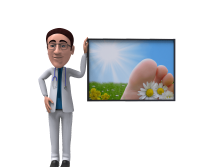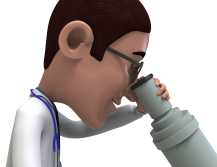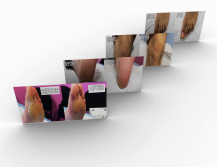
Will moisturiser get rid of thick hard skin?
No. Although moisturiser can make your skin feel as smooth as a baby’s bottom, it won’t get rid of thick layers of hardened skin. In some cases, a pumice stone or a file may be helpful in removing thickened skin, but more severe cases may require removal with a scalpel. We strongly advise that you consult a professional for this.
How can I stop my feet from getting dry?
Often, a condition of dry feet (as with other parts of the body) is simply due to the use of harsh soaps. In these cases, it is usually enough to use a milder soap, along with reducing the time spent in a hot shower and using a moisturiser. In some cases, however, dry skin can be a result of certain illnesses such as diabetes or hypothyroidism. If in doubt, seek professional advice.
What’s the difference between a corn and a verruca?
The easy answer would be that corn is a vegetable and a verruca is an area of hardened skin, but I’m afraid the answer is a bit more difficult. A corn is hardened skin resulting from increased friction or pressure on the foot, especially on the toes. A verruca is also an area of hard skin, but it results from a viral infection – the Human Papilloma Virus (HPV), in fact. verrucas are contagious and are easily transmitted from one person to another, or to different parts of the same foot.
What’s the difference between a corn and a callus?
Corns are well-defined areas of thickened skin that tend to occur on bony prominences of the feet, such as the outside of the little toes and the top of other toes. They are cone shaped, with the point of the cone pointing down into the skin. It is this central core of hard skin that distinguishes a corn from a callus, and what often makes a corn very painful. Calluses don’t have this central core of hardened skin. They are less well-defined than corns and, though generally painless, can be painful if the build-up of skin is sufficient. Calluses usually occur on the bony area of the sole of the foot, just beneath the toes, or at the heel. They often have a yellow colour to them and the thickness of the skin can make them less sensitive to touch.
Can corns be inherited?
Lots of things can be inherited, however, corns themselves do not have a genetic cause. Nevertheless, it is possible to inherit a foot structure from parents that may predispose you to the development of corns.
Will removing the root from my corn get rid of it for good?
No, for the simple reason that a corn has no root to remove. It’s true that there is a central core of hard skin, which points down into the skin – but it’s a misconception that this is a root. Removing this central core will not permanently prevent the corn from growing back – to do this, you need to remove the cause of the corn, which is excess pressure, often caused by ill-fitting footwear.
What are bunions?
Bunions, although they sound like it, have nothing to do with onions. A bunion is a swelling or bump at the base of the big toe which can be painful. Bunions occur when structural changes in the big toe causes it to deviate towards the second toe, resulting in a swelling on the side of the big toe. The disorder starts off as a slight change in the angle of the big toe – an angle which then becomes sharper with a consequent increase in the size of the bump. A bunion often looks inflamed, and there may be a burning sensation.
Should I treat my bunions or leave them alone?
A wise general rule is that, unless they’re hurting you or affecting the way you walk, you’re best to leave them alone.
Can a verruca be inherited?
No. A verruca is a viral infection of the Human Papilloma Virus (HPV), and is acquired, not inherited. Verrucas are often caught when walking barefoot in damp communal areas such as changing rooms, showers or swimming pools.
Are verrucas dangerous?
If you saw a fruit fly and thought it was dangerous, then I’m afraid verrucas are very dangerous to you, because all verrucas really are is a mild inconvenience. You may have heard that the virus that causes verrucas is the same as the virus that causes cervical and penile cancer, this is not true. Although the verruca virus is part of the Human Papilloma Virus (HPV) family, there are over 100 different types of HPV and the ones that cause verrucas are different from the ones that are linked to cervical and penile cancer.
Is there a vaccine for verrucas?
No. As yet there’s no vaccine for the type of Human Papilloma Virus that causes verrucas.
My feet are flat, do they need treatment?
Flat feet typically aren’t problematic, but you should consider getting a physical assessment done if you’re experiencing painful symptoms in your lower limb joints. A huge number of people in Asia have flat feet, yet do not have other joint complaints.
Should I burst my blister?
Generally speaking, it’s wise to leave blisters alone. They are the body’s natural response to injury or friction, and the body will – in time – reabsorb the fluid in the blister. At that point, the skin will be dry and safe to remove. If the skin is removed too soon, there is a threat of an infection. If the blister is painful, padding is easily available from your local pharmacist. If the pain is too intense, you should seek medical help to drain the blister safely.
Why do I need to take special care of my feet if I am a diabetic?
The high blood sugar level present in diabetics can affect the nervous system, often leading to reduced sensation in the feet. This can make the sufferer more prone to injury as a result of reduced sensitivity to pain. This, in turn, can lead to an ulcer and subsequent infection – which, in very severe cases, can result in amputation.








